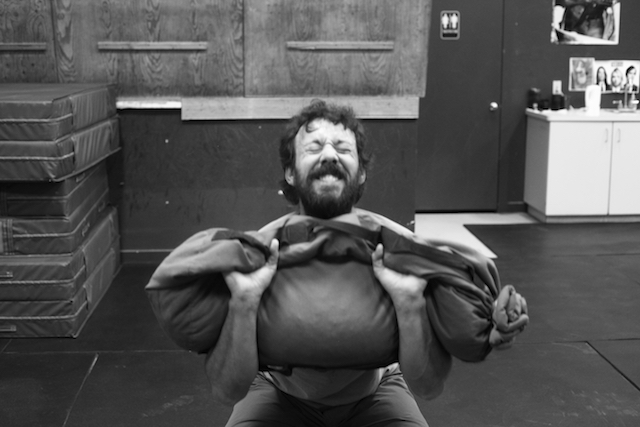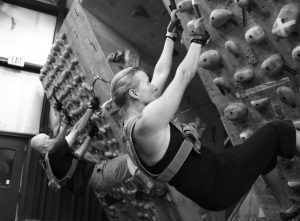By Rob Shaul
Over nearly a decade of operating Mountain Athlete, I’ve worked with multiple full-time professional mountain guides, and have come to better understand their gym-based training needs.
Along the way, I made several mistakes based on wrong assumptions and immature programming. Here are the lessons I learned from those mistakes:
(1) Avoid High Volume, Leg Intensive Training
A major mistake early on was not realizing the volume of work guides put on their legs and lungs while guiding and throwing them in with a leg-intensive general fitness training session – especially a longish (20 -30 minute) quad-intensive work capacity effort. This was just adding more volume on top of what they already did, and doing more to exhaust them than train them.
(2) Include Heavy, but Low Volume Squats, Hinges, and Lunges
While guides spend plenty of time walking up and down steep trails under load, this doesn’t mean necessarily they are “strong” in weight room terms. What I’ve discovered working with guides, skiers and ultra runners, is their sports or work build great strength endurance, but not necessarily strength, and in isolated loaded exercises like squats, lunges, and hinge lifts, they can be surprisingly weak. The way to make athletes stronger is with heavy loading, but low volume – think 6 or 8 heavy sets of 3 reps front squat, heavy walking lunges or hinge lifts. What I’ve found is if we keep the load heavy, but volume low, we can increase guides’ strength without exhausting them through too much volume.
Why do guides need stronger legs? A couple of reasons …. durability and “mountain chassis” integration (see below).
(3) Train the Mountain Chassis for Durability, not Performance
Most of the guides I work with are full-time guides – they alpine and rock guide during the summer, take a 4-6 weeks off in the fall to go desert climbing, then ski mountaineer or backcountry ski guide in the winter, take 4-6 weeks off in the spring to go desert climbing, then repeat the cycle again. They have so much “training” age and endurance when it comes to hiking or skinning/skiing up and down mountains, they need little job-specific programming during the season or even in the early pre-season.
So what do they get by strength training heavy legs in the gym? Durability and “Mountain Chassis” integration. Again, – work gives guides high strength endurance, but not good “strength.” I’m somewhat of a contrarian here, but feel strongly strength is the key to durability. Stronger athletes are simply harder to injury, don’t get injured as bad when something does happen, and recover faster.
For guides, our strength training focuses on their “mountain chassis” – legs and core – and it’s integration. Core strength work is a huge focus, and heavy front squats, walking lunges and hinge lifts help integrate legs and core strength in one exercise.
I believe professional mountain guides must be stronger than professional mountaineers or high-level recreational mountaineers. As a rule, guides’ packs are heavier – they can never go “light and fast” with clients. As well, guides have a rescue responsibility for their clients or others, which may require carrying extra packs, litters, or even people. They need strength.
Injuries often happen fast – having a rock roll while walking downhill, getting jerked on the rope while tied into a client, having to catch a person being spotted at the beginning of a climb – my goal is for the guide to be strong enough to pull their knee and ankle back inline when the rock rolls, have the mountain chassis leg/core integration and strength to now tweak their back when jerked by the rope, and similarly avoiding a back or other injury catching a shortfall.
(4) Include Volume Hamstring Work for Strength Endurance Balance with the Quads
Hiking up and downhill is quad and calf intensive, and can lead to a major strength imbalance with the hamstrings … which can lead to knee issues. To balance out, I program in high rep, mostly bodyweight, hamstring specific exercises like the Poor Man’s Leg Curl or Hamstring Hell.
(5) Train the Upper Body
While guides lower body gets hammered at work, the upper body can waste away. Local guides here in the Tetons all laugh how at the end of the summer guiding season, they look like T-Rex dinosaurs …. big legs, and tiny, skinny arms and upper bodies. I program in moderate and light intensity (loading) upper body pressing and pulling work for guides to help address this. Again, I feel professional guides warrant more upper body strength than professional mountaineers because of their heavier loading and rescue responsibilities. A little upper body mass doesn’t hurt much either -as it can be “armor” for falls and client mishaps.
(6) Train Climbing Fitness
You would think that a mountain guide leading trad climbs in the Tetons would get plenty of climbing-specific fitness at work, but it’s not true. First, the routes guides lead clients up are generally far below their skill level, and they move at a client-pace which is much slower then they would move with a true partner. Indeed, during the winter when guides come in after a long day of backcountry ski guiding, they always want to work sometime in on our system boards to try and maintain a semblance of climbing fitness. During the summer guiding season, I program even more climbing specific volume and intensity to keep my guides climbing-fit.
(7) Use Short Work Capacity Events to Train Mental Fitness
Over the years, the professional guides we’ve worked with report that the gym-based work we do which most transfers to the mountain is core strength, and mental fitness. Core strength I understand, but I was surprised by mental fitness.
When I first started programming I called mental fitness, mental “toughness.” But mental “toughness” implies that you either have it or you don’t.
What I’ve come to learn is mental “fitness” is just like any other type of fitness – it can be coached, it can be deconditioned, and you need to train it, to maintain it.
We’ll use short (5-15 minute), intense, work capacity events to train mental fitness for our guides. Not only do they see the transfer to the mountain, but all my guides are competitive, and really enjoy this aspect of gym training.
Again – I need to be smart when I design these efforts, and not include a bazillion squats to add unnecessary volume to their legs. Often I’ll use shuttle sprints, or something similar, to achieve the intensity without quad-blasting volume.
In addition to working with full-time guides, we also work with several part-time guides – who work other jobs during the Fall, Winter, and Spring, but mountain guide during the summer.
These athletes, because they aren’t getting the ski mountaineering volume the full-time guides receive during the winter, do need job-specific programming in the pre-guiding season. For them, I’ll program in high volume loaded step ups to build their hiking fitness, and leg blasters or something similar to build their down-hill hiking ability – during their pre-guiding season train up.
But for the full-time guides, many of whom spend April in Moab crack climbing – I like to leave their legs alone – let them recover some from the winter, and before the summer hiking begins.
You Might Also Like The Mountain Guide: My 3 Most Dangerous Mountain Mistakes


